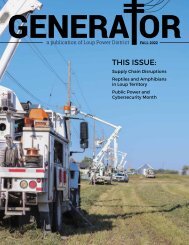Create successful ePaper yourself
Turn your PDF publications into a flip-book with our unique Google optimized e-Paper software.
While the forecast is generally accurate,<br />
the real-time energy market<br />
can still change every minute. Because<br />
prices are so volatile, there are times<br />
where Loup generates electricity into a<br />
negative market and loses money.<br />
Loup must put the promised<br />
amount of electricity onto SPP’s grid.<br />
If conditions change and Loup cannot<br />
meet that promise, we must buy it<br />
back at the real-time price.<br />
Another hurdle to generation planning<br />
is compliance with Loup’s license<br />
from the Federal Energy Regulatory<br />
Commission.<br />
License restrictions state that Loup<br />
must ensure minimum water flows in<br />
the bypass reach (the portion of the<br />
Loup River from the diversion weir to<br />
1<br />
its meeting with the Platte River). The<br />
District is also limited to a maximum<br />
diversion of 2,000 cubic feet per second<br />
from March 1 to June 7.<br />
But the operators’ duties don’t end<br />
there. The Columbus Powerhouse<br />
serves as an after-hours call center.<br />
Operators reconnect customers, take<br />
payments, answer outage calls and dispatch<br />
line technicians to those outages.<br />
They also monitor Loup’s substations<br />
and their security with the Supervisory<br />
Control and Data Acquisition<br />
(SCADA) system.<br />
Loup’s five Powerhouse Operators<br />
—Baxa, Jamie Held, Blane Konwinski,<br />
Justin Kohl, and Tony Miller — handled<br />
all these duties with success last<br />
year.<br />
2<br />
Prior to 2022, Loup sold its energy<br />
generation to NPPD and was paid for<br />
each kilowatt hour based on a formula<br />
tied to the average cost of NPPD’s<br />
generating facilities.<br />
In their first year navigating the<br />
SPP market, the operators beat the<br />
generation revenue forecast by nearly<br />
$1.5 million and did so with less water<br />
than the previous year.<br />
But the operators are quick to point<br />
out that the success is due in large part<br />
to their fellow employees at the Headworks<br />
and those on the canal crew.<br />
Headworks employees operate the<br />
intake gates, diverting as much water<br />
as possible based on river conditions<br />
and license restrictions. They, too,<br />
constantly monitor the water levels<br />
and alert the operators to any changes.<br />
The canal crew employees help<br />
maintain the canal system, ensuring<br />
that everything is working properly.<br />
And together, they made certain<br />
that their calculated risk paid off.<br />
Loup Power District generates electricity<br />
at its powerhouses in Monroe and Columbus.<br />
NPPD — Loup’s wholesale energy provider<br />
— bids the electricity (along with its own) into<br />
SPP’s wholesale energy market, competing<br />
against other generators.<br />
3<br />
5<br />
SPP selects the lowest-cost<br />
resources based on fuel and variable<br />
operation and maintenance costs.<br />
Loup purchases energy<br />
from NPPD to serve customers.<br />
4<br />
10 | GENERATOR<br />
NPPD buys energy back from SPP<br />
to serve customers, including Loup,<br />
at a market price.
















